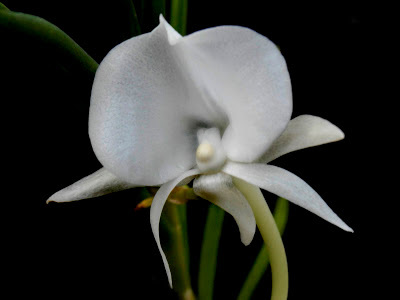Angraecum scottianum, a species of angraecoid used as a parent to one of the most popular Angraecums sought after by hobbyists to date; Angraecum Longiscott. Angcm. scottianum is also one of the easiest Angraecums to grow in culture. I have several of the plants at various stages of growth from a seedling to a few mature plants. I will concentrate on the development of the seedling in this post to its first bloom.
Angraecum scottianum originates from Grande Comore Island in the Comoro Islands. It is found on the western slopes of Mt Karthala at about 1,300 - 1,950 feet (400-600m). It is an epiphyte that grows on the trunks and lower branches of large trees. Angcm. scottianum is usually found growing on the west side of the trees being exposed to almost full afternoon sun. I'll address this in detail for plants in culture a bit later in this post.
Angcm. scottianum will grow well either mounted or in a pot/basket. You will find that growing it in a pot/basket, you'll need to stake it. The plant becomes very pendulous and wiry. By mounting it to a tree-fern totem, the aerial roots that develop from the lower quarter of the plant will have an opportunity to attach to the totem. The tree-fern material will also give good drainage when watering and give the roots the ability to breath and not become stagnant. During the warm summer months the plant will need to be watered daily and often misted in the later part of the day. I water my plants everyday for almost ten months; backing off to every other day in December and January (temperatures are averaging low to mid 70s F). If the temps drop below 70 degrees F (50s - 60s F) I will back off on the water a third day, never more than that. Angcm. scottianum has a very short rest period, if at all.
When fertilizing Angcm. scottianum, I do nothing different than I usually do. Fertilizer is applied every seven days throughout the entire growing season and is only backed off to every 10 - 14 days in December and January. I use a systemic fungicide every 30 days (Thiomyl). Keep in mind that you should alternate your fungicides to prevent issues of immunities. You can check with your local orchid growers about alternates. I also use Dithane and Clearys. I also keep Physan 20 on hand in a quart spray bottle (a good topical fungicide) for minor problems that arise between my regular treatments.
The overall length of Angcm. scottianum's stem will vary between 8 - 16 inches (18-40cm) and will eventually become pendulous in a more mature plant. Branching will develop at the lower to mid section of the plant. Plants that have a stem barely 2 inches (5cm) tall can and usually will bloom.
Angcm. scottianum seedling with bud
Angcm. scottianum seedling with bud
The leaves are terete and usually about 4 - 5 inches (10-13cm) long. Each leaf having a groove running the length on the top side of the leaf. With the leaves being terete and somewhat thin, the plant will take very bright light, although direct mid-day sun light should be avoided. Morning and late afternoon sunlight is fine. With plants that are grown in the upper north, an east or west window will do fine. The plant can also be placed on a table several feet from the window. The root system will eventually put out aerial roots, although not much higher than 4 inches (10cm) from the base.
The inflorescence is 2 - 5 inches (5-13cm) long on mature plants and can put up to 8 flowers each.
Flowers usually open in pairs successively over a period of about 2 months. In younger plants, the flowers may be borne singularly on a pedicle of about 1 inch (2.5cm). As the inflorescence developes, multiple sheaths will cover the bud. As the bud grows, the sheaths will separate as a snake sheds it's skin. The sheaths protect the developing bud as long as possible.
 Angcm. scottianum bud development
Angcm. scottianum bud development
Once the flowers of Angraecum scottianum open, they are 2 - 2.5 inches (5-6.5cm) across. The petals and the sepals are about 1 inch (2.5cm) long with the petals being slightly narrower than the sepals. The nectary or spur is usually about 4 - 6 inches (12-15cm) long. They have a waxy substance and have a faint fragrance of seet honey. The peetals and sepals open with a yellowish green tint and turn pure white as the lip.
 The flowers can last up to three weeks if the plants are kept out of the elements. Here in the northern hemisphere, the blooming period can range from mid February into mid October in the sub-tropical regions . Heaviest during the warmer months of June through late August in the more temperate areas.
The flowers can last up to three weeks if the plants are kept out of the elements. Here in the northern hemisphere, the blooming period can range from mid February into mid October in the sub-tropical regions . Heaviest during the warmer months of June through late August in the more temperate areas.
